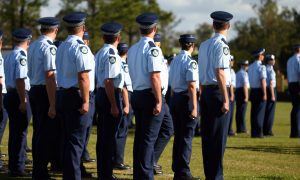IMPORTANT: The information below might be outdated, therefore visit SFPD’s official recruiting page for updated details.
If you want to work for the San Francisco police department there are several unique branches within the department that may interest you. But for those who just want to be a patrol person, you must be at least 21 years old, be a United States citizen, possess a valid California driver’s license, and never have been convicted of a felony or certain misdemeanor offenses like domestic battery.
As I mentioned earlier, there are other components inside the department that can peak your interest if you’re ultimately eliminated during the hiring process. One component is to become a civilian employee in the Behavioral Science Unit or other non-police functions like a counselor and/or a Chaplin. All employment requires the minimum of a high school diploma or a GED.
Patrol officers in San Francisco start off between Salary $89,856 – $135,096 per year. San Francisco is really competitive when it comes to police officer compensation.
Police officers on the force are also able to retire as young as 50 years old and can draw a maximum 90% benefit based on their cumulative years of service. Candidates must keep an eye on future testing as the San Francisco police department conduct their test twice per quarter. Currently as of today’s date, the department is accepting applications online and has an examination date set. You can call the recruiting department to get the test site address and exact date of the exam.
Getting a hold of the recruiting department is critical as you must reserve a space to even take the pre-employment written test. The written exam is usually given eight times per year, twice per quarter about 2 months apart. The exam consists of the physical assessment and written. Applicants who pass the written and agility test will move on to the background check and later the oral board interview.
THE PHYSICAL ABILITY TEST
All physical ability training sessions are conducted at:
San Francisco Police Academy
350 Amber Drive
San Francisco, CA 94131
The San Francisco Police Officer Examination has three parts that will occur in the following order:
1) the written test
2) the physical ability test, and
3) the oral question and answer test.
The information provided herein is to help you ready yourself for the physical ability test (see Exercise Model below for more information)
The physical ability test will consist of the following:
Work Sample: Run through an obstacle course involving ducking under bars, going over a 3-foot high barrier, stepping over a curb, pushing a 225 lbs. sled 5 feet, and dragging a 140 lbs. dummy 25 feet.
Sit-ups: Perform sit-ups, as fast as possible, for 60 seconds.
Arm Lift: Complete a single maximal contraction using a recording device to determine maximum force generated by arm muscles (three trials).
Leg Endurance: Pedal a bicycle, as fast as possible, for two minutes.
Trigger Pull: Pull a gun trigger in a confined area 12 times within 25 seconds (each hand).
How to Prepare for the Physical Ability Test
The following is a suggested exercise model that will help you prepare for the physical ability test. It requires no special equipment and can be done at very low cost. It consists of a warm-up drill, exercises, and a cool-off drill. You should consider exercising every other day.
When candidates take the physical ability test, they must wear gym shoes or sneakers. As a practical consideration, they should wear gym clothes, although these are not strictly required. An investment in gym shoes and gym clothes is a good idea.
A warm-up drill is an important part of any exercise program. It helps you flex and stretch your muscles, and prepare for the more strenuous efforts to follow. An efficient warm-up drill should take at least 5 minutes. The following are warm-up drill suggestions.
1. THE WALL PUSH:
Stand facing a wall, about an arm’s length away. (Any wall will do: indoors, outdoors, in the kitchen, in the living room.) Put both hands on the wall at shoulder height. Keep the back straight. Put the left leg straight back. Bend the right leg at the knee. Push against the wall with both hands for 20 seconds. Put the right leg straight back straight. Bend the left leg at the knee. Push against the wall with both hands for 20 seconds. Repeat the drill 3 times for each leg.
2. ANKLE STRETCH:
Balance on your right foot. Pull your left foot up behind you until it touches your rear end. Hold it for 20 seconds. Balance on your left foot. Pull your right foot up behind you until it touches your rear end. Hold it for 20 seconds. Repeat the drill 3 times for each foot.
3. KNEE TO CHEST:
Balance on the left foot. Pull the right knee to the chest. Hold the knee in place for 20 seconds. Balance on the right foot. Pull the left knee to the chest. Hold the knee in place for 20 seconds. Repeat the drill for both knees 3 times.
4. CROSSOVER TOE TOUCH:
Stand with the right leg crossed over the left leg. Bend over and try to touch the toes for 5 seconds. Stand with the left leg crossed over the right leg. Bend over and try to touch the toes for 5 seconds. Repeat the drill for both legs 3 times.
5. SIDE STRETCH:
Stand with arms outstretched at shoulder height. Bend sideways to the left and try to touch the ankle. Hold the position for 5 seconds. Bend sideways to the right and try to touch the ankle. Hold the position for 5 seconds. Repeat the drill for both the left and right hands 3 times.
6. SITTING TOE TOUCH:
Sit on the floor with legs outstretched and feet together. Bend over and try to touch the toes. Hold the position for 5 seconds. Repeat the drill 3 times.
7. JOG IN PLACE:
Jog in place for 1 minute. Be sure to lift each foot off the ground during the drill.
UPPER BODY EXERCISES
1. PUSH UPS:
Lie on the floor, face down, back straight, feet together. Place the hands on the floor, on either side of the chest, with elbows bent. Push the body off the floor with the hands. Keep the feet together and the back straight. When the body is off the floor and the elbows are straight, hold the position for 10 seconds. Repeat the exercise 5 times.
2. DOOR PULLS:
Stand before an open door. Curl both hands over the top of the door. Pull the body up towards the top of the door. Hold the position for 5 seconds. Repeat the exercise 5 times.
3. PINK PEARL (The trigger pull exercise requires strong wrist and forearm muscles; thus we recommend this exercise):
Buy a soft, Pink Pearl rubber ball at a discount store for around $1.00. If you have a dog, borrow one of his or her slightly used tennis balls. Squeeze the ball 10 times in one hand and 10 times in the other. Keep the ball in your bag or back pack. Squeeze 10 times in each hand every other hour or so.
LOWER BODY EXERCISES
1. SIT UP:
Rest your back flat on the floor, hands laced behind your head, knees bent. Bring the head up slowly and try to touch the knees. Hold the position for 5 seconds. Repeat the exercise 5 times.
2. SQUATS:
Stand up straight with fingers laced behind your head. Bend the knees and lower the body so that your rear end almost touches the floor. Hold the position for 5 seconds. Repeat the exercise 5 times.
3. JOGGING:
Jog on the grass or on a dirt road. Try not to jog on cement. Start out by jogging for 5 minutes. Build up your jogging time slowly to 15 or 20 minutes.
4. OTHER IDEAS:
If you have a bicycle, try to ride 30 minutes every other day. If you have access to a pool, try to swim 15 minutes every other day.
COOL DOWN
Once the exercises are finished, it is important to relax the breathing and the heart, and calm down. The following cool-down drills are offered as suggestions.
1. SLOW ARM STRETCH:
Sit on the floor with legs straight and comfortably spread. Stretch the arms and attempt to touch the feet. Hold the position for 5 seconds, then slowly sit up. Repeat the drill 5 times.
2. SLOW BACK STRETCH:
Lie on your stomach and hold your upper body off the floor with your arms. Slowly bend your back up and look up. Hold the position for 5 seconds. Repeat the drill 3 times.
3. SLOW STANDING STRETCH:
Stand with your feet shoulder width apart. Slowly bend over and try to touch the floor with your hands. Hold the position for 5 seconds. Repeat the drill 3 times.
Q-2 Police Officer Background Information and Oral Interview Preparation
Following the successful completion of the oral examination, you will be required to submit the documents listed below. As some of these documents require several weeks to obtain, start compiling these documents NOW.
Do not bring these items to the testing process. You will need to provide these items when you submit your background packet. A certified copy of your birth certificate. If you do not have one, you may obtain one by writing to County Recorder, city of your birth.
Copies of high school and college diploma(s).
Official transcript(s) from high school and college or G.E.D. Certificate and scores.
All veterans will be required to provide a copy of DD214.
Citizenship is necessary at the time of appointment. If you have been naturalized, you will be required to provide your Certificate of Naturalization when contacted by your investigator.
Marriage certificate(s). (Certified copy or have your original with you at the time of the background interview, once contacted by an investigator.)
Dissolution/Divorce Decrees.
Copies of any restraining orders issued or filed.
Copy of vehicle insurance policy.
A recent photograph (passport size) is requested for identification purposes.
Certified copies of any bankruptcy proceedings.
Additionally, the Police Department will need to know for the last ten (10) years:
your places of residence
persons with whom you have resided
places of employment
names of coworkers and supervisors
names of all law enforcement agencies with whom you have applied.
Begin to gather the information and required documents NOW.
ORAL INTERVIEW PREPARATION
SAMPLE EXERCISES (PRACTICE SCENARIOS)
The Oral Board Examination is comprised of two hypothetical scenarios in which the candidate must assume the role of a police officer. At the beginning of the interview, the candidate will be asked to choose one of two extreme courses of action in response to the first scenario. Note, there is no right or wrong answer to the question “What course of action did you choose?” The candidate will then be asked a series of questions based on the course of action she/he chose. The questions are designed to elicit the candidate’s perception of the scenario’s hypothetical situation, insight into the characters involved in the scenario, and his/her ability to appropriately adapt to changes within that situation. Follow-up questions will be the same for each candidate who selects that course of action for a given scenario.
It is the response to the follow-up question that determines the candidate’s ratings. Ratings are determined by what the candidate has to say about his or her choice and the responses to the follow-up questions based upon that choice.
After completion of the first scenario, the candidate will be given five minutes to review a second scenario. Following this review period, the candidate will be asked questions based on the second scenario.
The behavioral dimensions on which the candidates will be rated are defined as follows:
INTEGRATION: (covered in both scenarios)
The ability to identify and analyze facts, and to make logical, appropriate and reasonable decisions. The ability to balance the need to perform job responsibilities with the need to protect the rights or interests of the citizens.
EMOTIONAL COMMAND: (covered in first scenario)
Interacts with people in a manner which demonstrates respect for individuals, and a sensitivity to the personal differences of each; demonstrates the ability to establish rapport and evoke confidence; is able to separate personal feelings and emotions from working judgments, and exercises self control.
ADAPTABILITY: (covered in second scenario)
The ability to re-evaluate the situation when presented with change, and to appropriately adjust actions, thoughts and/or approach to attain resolution.
SAMPLE EXERCISES
The oral examination will test:
Listening and oral communication skills,
The ability to make common-sense decisions,
The ability to maintain emotional control,
The ability to adapt to changing situations.
HOW THE ORAL EXAMINATION IS ORGANIZED
Report to the examination site, show photo identification, and sign in.
Report to an orientation room, read the civil service rules that govern testing, read the first test scenario, and listen to it on audio tape.
Read the second test scenario and listen to it on audio tape.
Review both scenarios and take notes.
Report to the interview room for both interviews.
After all candidates in your track have finished the interview, you will turn in our scenarios and leave the test site.
GETTING READY FOR THE ORAL EXAMINATION
Practice the scenarios in this booklet and write similar scenarios on your own. Remember that candidates will not be expected to have legal or police-related knowledge. Rather, candidates will be expected to respond to the scenarios in a common-sense fashion.
Get a good night’s sleep before the test.
Have a light meal before the test.
Business attire is suggested but not required.
No fraternal rings, organization pins, uniforms, or insignias of any kind shall be displayed by any candidate who appears before the board in any qualification appraisal interview.
TAKING THE ORAL EXAMINATION
Be on time.
When you enter the interview room, introduce yourself and shake hands with each interviewer.
Sit up straight and make eye contact with the interviewers.
Relax and breathe during the interview.
Listen carefully to the questions before you answer.
If you do not understand a question, say so.
When you answer a question, be responsive but not hasty.
When you finish your interview, thank the panel and leave the room.
Be seated in the hall until instructed to leave.
BACK TO ORAL INTERVIEW PREPARATION
PRACTICE SCENARIOS
The following two practice scenarios are similar to the ones you may see on the real test. Practice answering the questions in each scenario.
PRACTICE SCENARIO ONE: THE BARKING DOG
It is 10:00 A.M., Tuesday, and you are on patrol alone. You are dispatched to a well-to-do neighborhood to investigate a complaint from a lady who lives there. As you drive up before a four-story home, you see a well-dressed lady standing on the curb. She taps her foot impatiently and looks over her shoulder several times. In the distance you hear a dog barking.
As you get out of your car, the lady steps off the curb and says,
“It’s about time you got here! Do you hear that dog barking? He tried to bite me this morning! You have to do something about it!”
Just then a man with a large dog emerges from the house across the street. The man is struggling to control the dog on its leash. As you watch the dog lunges toward the lady. The man manages to pull back the dog just before he reaches the lady. The man looks at you and says, “I don’t know what she has told you, but the dog never touched her. I always keep him under control.”
The lady says,
“That’s the dog that tried to bite me this morning! Do something!”
Choose A or B.
A. Order the dog impounded.
B. Take no police action.
PRACTICE QUESTIONS
1. What course of action did you choose?
2. What factors influenced your decision?
3. How do you think you would feel if you were the lady?
4. How do you think you would feel if you were the man?
5. How would you feel if the lady confronted you with, “You cops are all the same – too lazy to do your job.”
6. How would your personal feeling affect your actions and why?
PRACTICE SCENARIO TWO: THE BOOKSTORE
It is 9:00 A.M., Wednesday, and you have been dispatched to a bookstore in the financial district to investigate a complaint. As you enter the bookstore you see a young black woman arguing with a middle-age white man. She is dressed in blue jeans and a T-shirt and has a large earring hanging from her nose. He is dressed in a conservative grey business suit.
When they see that you have entered the store, they stop arguing. The lady immediately shouts:
“He tried to walk out of my store without paying for that book.
He’s a thief! Arrest him!”
The man laughs and shakes his head. He says,
“That’s nonsense! She’s hysterical. I left the money for that book. Look, there’s my money on the cash register.”
Choose A or B.
A. Arrest the man.
B. Take no police action.
PRACTICE QUESTIONS
1. What course of action did you choose?
2. What factors influenced your decision?
3. Based upon the original scenario, would your course of action change if the woman was middle-aged?
4. Based upon the original scenario, would your course of action change if the man was not able to point out the money on the cash register?
5. Based upon the original scenario, would your course of action change if clerk said, “I didn’t notice the money on the cash register”?







